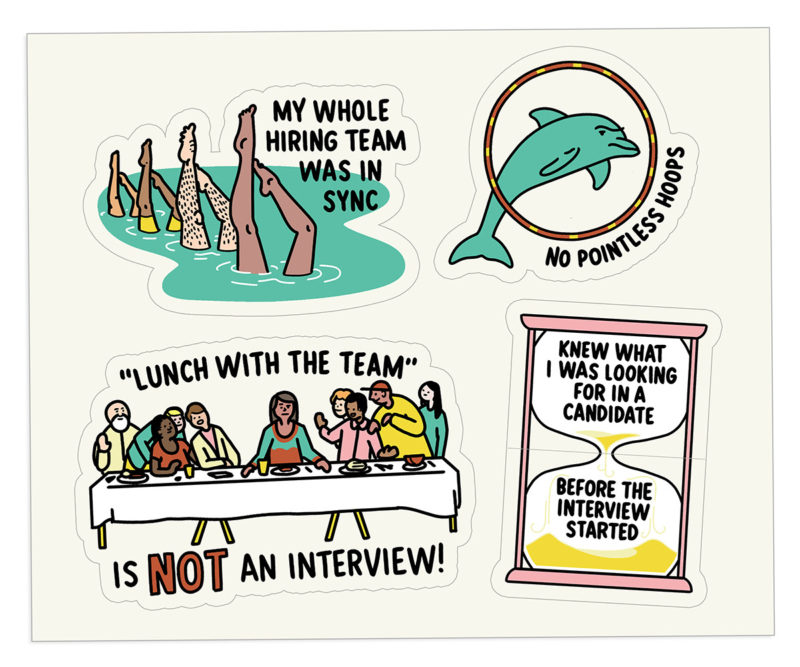Emma: The whole hiring process is completely absurd. You’re essentially swiping on a Tinder profile, going on a speed date where they also meet a few of your friends, and then you decide if you’re going to get married two weeks from Monday, 9am sharp.
Andy: There’s a lot riding on that yes or no decision. It’s damaging to introduce a bad apple to a team, it’s exhausting to try to coach the blight out of that person, it’s complicated to fire them. Every time I’ve mis-hired, the error lingers — with me, with my team, with the goals I was trying to achieve by hiring that person in the first place…
Emma: It’s why interviewing these days can have so many stages: phone screens, hours-long take-home tests, working sessions with the team, lunch with the CEO, references, bar raisers, “What kind of tree would you be?” As a hiring manager, I’ve created all sorts of hoops for candidates to jump through. I’m just trying not to blow it.
Andy: Unfortunately, even the most extensive interviews aren’t true examples of what it’ll be like to actually work with someone. And adding more interviewers to the loop doesn’t add value when they’re all covering the same ground, which, in my experience, is pretty typical.
Emma: Absolutely. I didn’t get much instruction when I started interviewing people. If I got any advice, it was “you should ask XYZ question” or something like “be comfortable in the silence,” both of which are about as helpful as someone recommending to “use your legs!” when you’re about to go rock climbing for the first time. It’s not wrong advice, but can someone please tell me what I’m actually supposed to be doing?
Andy: I’m totally guilty of hurling teammates into an interview with as much care as a bird shoving it’s chick out of the nest. And I know how hard interviewing is! Humans aren’t actually all that great at making good decisions. We like people who are like us, we dislike what’s different, we are confused about time: things that happened recently are more powerful than things that happened farther back. We are happy when we can confirm what we already think, we don’t like to disagree with the rest of the group, and every interview starts with the goal of hiring that person, so we’re biased there too. Not hiring can feel like failure, even if it’s the right thing to do.
Emma: The most helpful interview training I ever got was about the prepwork, not about the conversation part. The point of any interview is to get concrete evidence that the candidate can or cannot meet the expectations you have for the role on your team.
Andy: Identifying what that evidence will look and sound like is absolutely something that should be done as a full hiring team, not alone in an echo chamber of our personal preferences. If you’re the hiring manager, you’ve got to calibrate with your team on what the ideal candidate will demonstrate, and what are dead-in-the-water dealbreakers.
Emma: Do this before you’re face-to-face with the candidate. If you wait until after the interview, your decision is only going to be “data-inspired.” I like the way Cassie Kozyrkov talked about it in her article on the need for having a decision context up front in the Harvard Business Review last week:
“Many decision-makers think they’re being data-driven when they look at a number, form an opinion, and execute their decision. Unfortunately, such a decision will be ‘data-inspired’ at best. Data-inspired decision-making is where we swim around in some numbers, eventually reach an emotional tipping point, and then decide.”
Andy: If you’re assigned to an interview loop, and you’re not totally sure what you’re supposed to be seeking out in your 30 or 45 minutes, be brave enough to ask the obvious-seeming questions: What is this interview about? What will a successful candidate talk about? What are the big red flags I should follow up on?
Emma: And then, be comfortable in the silence.
Pre-Interview Prep Work
We like to do this four-question exercise with the entire hiring team to ensure everyone who’s meeting a candidate is aligned on what they’re looking for. It’s also a nice solo refresher anytime you’re about to step into an interview room. These questions aren’t rocket science, but doing this work before you interview makes it clearer to see who’s a yes and who’s a no — beyond their sparkling resume.
What I’m looking for in my interview loop?
Think of the core values, behaviors, and technical skills a candidate needs to be successful in the role. Some might be company-wide mandates, like humility or bias for action. Others might be more specific to your team — maybe the role is highly collaborative or demands attention to detail. There’s only enough time to suss out one or two qualities per 30- or 45-minute interview loop. We recommend no two loops overlap in what they’re looking for.
What are my green lights?
What does the quality you’re assessing look like on your team? What does it sound like? What examples can the interviewee give that will make you confident they’re right for the role? These things should be hyper-tailored and agreed upon by everyone on the hiring team.
What are my red flags?
Red flags are the opposite: what types of behavior or decision-making might a candidate describe that shows they’re not a fit for the role or team?
What two questions will start a conversation that reveals green lights and red flags?
These will almost certainly be tell-me-a-time questions. For example, if we were looking for meticulousness, we might ask, “Tell me about the most intricate project you’ve ever worked on.” Two questions are all you need to get started. The rest will come naturally as you follow up to get to the information you need.
- Q1:
- Q2:




